POS System Analysis: Impact of IT on Business - Holmes Institute
VerifiedAdded on 2023/06/12
|11
|2270
|396
Report
AI Summary
This report provides a comprehensive analysis of information systems, focusing on the impact of Point of Sale (POS) systems on business operations, referencing a case study of Four Seasons Greenhouse and Nursery. It explores the advantages and disadvantages of POS systems, highlighting their role in data management, competitive advantage, and decision-making processes. The report discusses the benefits of a centralized database, telecommunication options for POS systems, and potential risks, including privacy and security concerns. It also suggests solutions like data encryption and security policies to mitigate these risks. Ultimately, the report concludes that POS systems offer significant benefits to businesses by improving data analysis, reducing costs, and enhancing customer engagement.

POS system 1
IT FOR BUSINESS
[Author]
[Professor]
[University]
[City, State]
August 29, y
IT FOR BUSINESS
[Author]
[Professor]
[University]
[City, State]
August 29, y
Paraphrase This Document
Need a fresh take? Get an instant paraphrase of this document with our AI Paraphraser
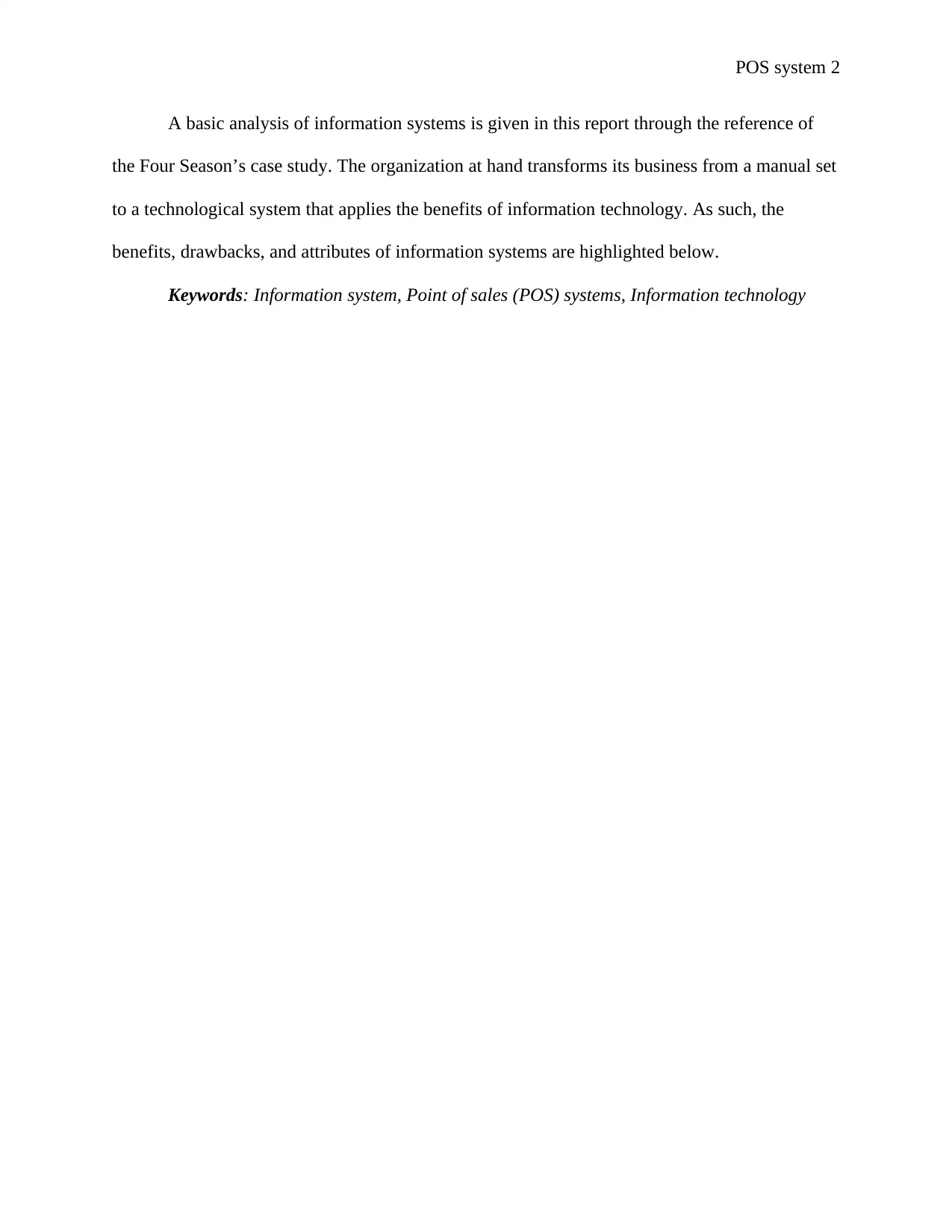
POS system 2
A basic analysis of information systems is given in this report through the reference of
the Four Season’s case study. The organization at hand transforms its business from a manual set
to a technological system that applies the benefits of information technology. As such, the
benefits, drawbacks, and attributes of information systems are highlighted below.
Keywords: Information system, Point of sales (POS) systems, Information technology
A basic analysis of information systems is given in this report through the reference of
the Four Season’s case study. The organization at hand transforms its business from a manual set
to a technological system that applies the benefits of information technology. As such, the
benefits, drawbacks, and attributes of information systems are highlighted below.
Keywords: Information system, Point of sales (POS) systems, Information technology
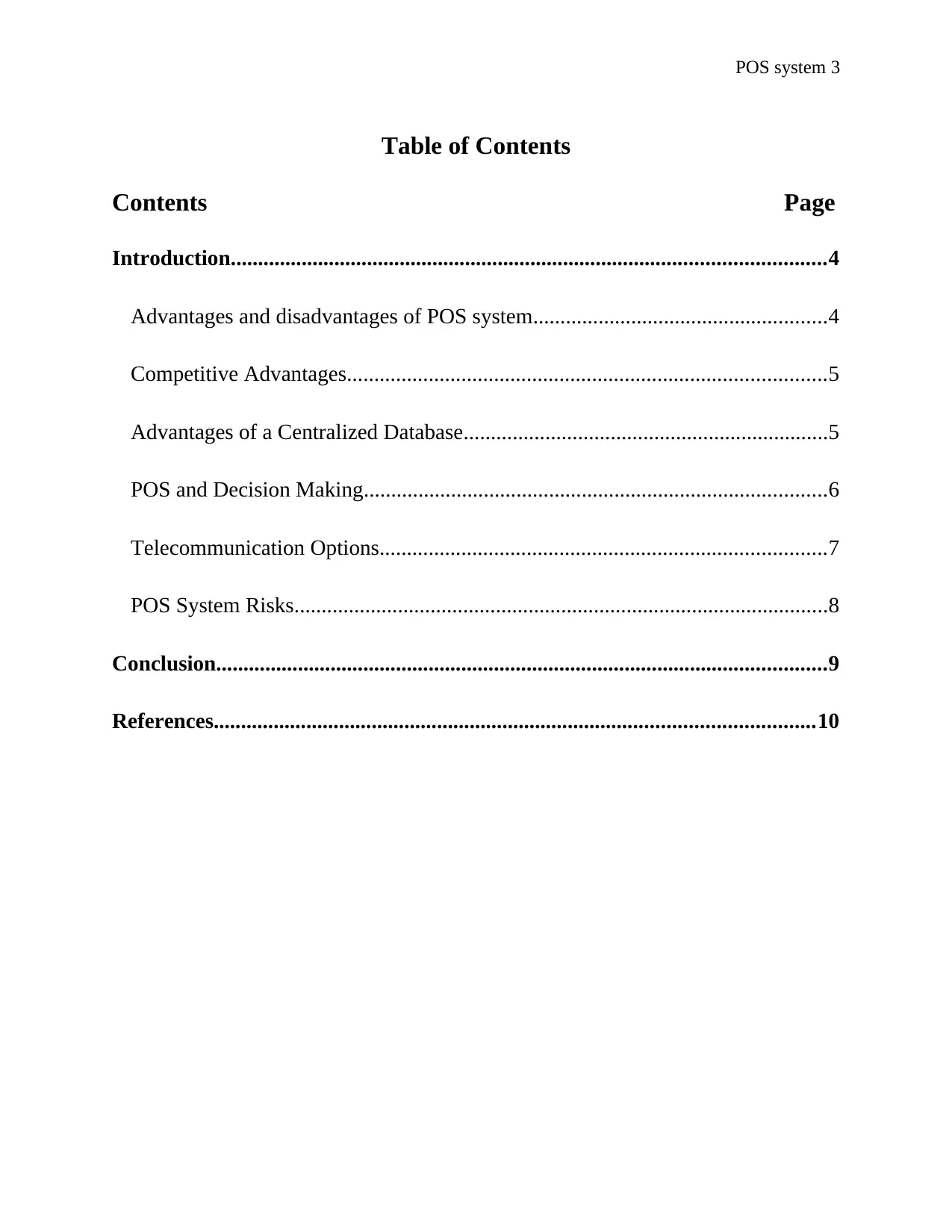
POS system 3
Table of Contents
Contents Page
Introduction.............................................................................................................4
Advantages and disadvantages of POS system......................................................4
Competitive Advantages........................................................................................5
Advantages of a Centralized Database...................................................................5
POS and Decision Making.....................................................................................6
Telecommunication Options..................................................................................7
POS System Risks..................................................................................................8
Conclusion................................................................................................................9
References..............................................................................................................10
Table of Contents
Contents Page
Introduction.............................................................................................................4
Advantages and disadvantages of POS system......................................................4
Competitive Advantages........................................................................................5
Advantages of a Centralized Database...................................................................5
POS and Decision Making.....................................................................................6
Telecommunication Options..................................................................................7
POS System Risks..................................................................................................8
Conclusion................................................................................................................9
References..............................................................................................................10
⊘ This is a preview!⊘
Do you want full access?
Subscribe today to unlock all pages.

Trusted by 1+ million students worldwide
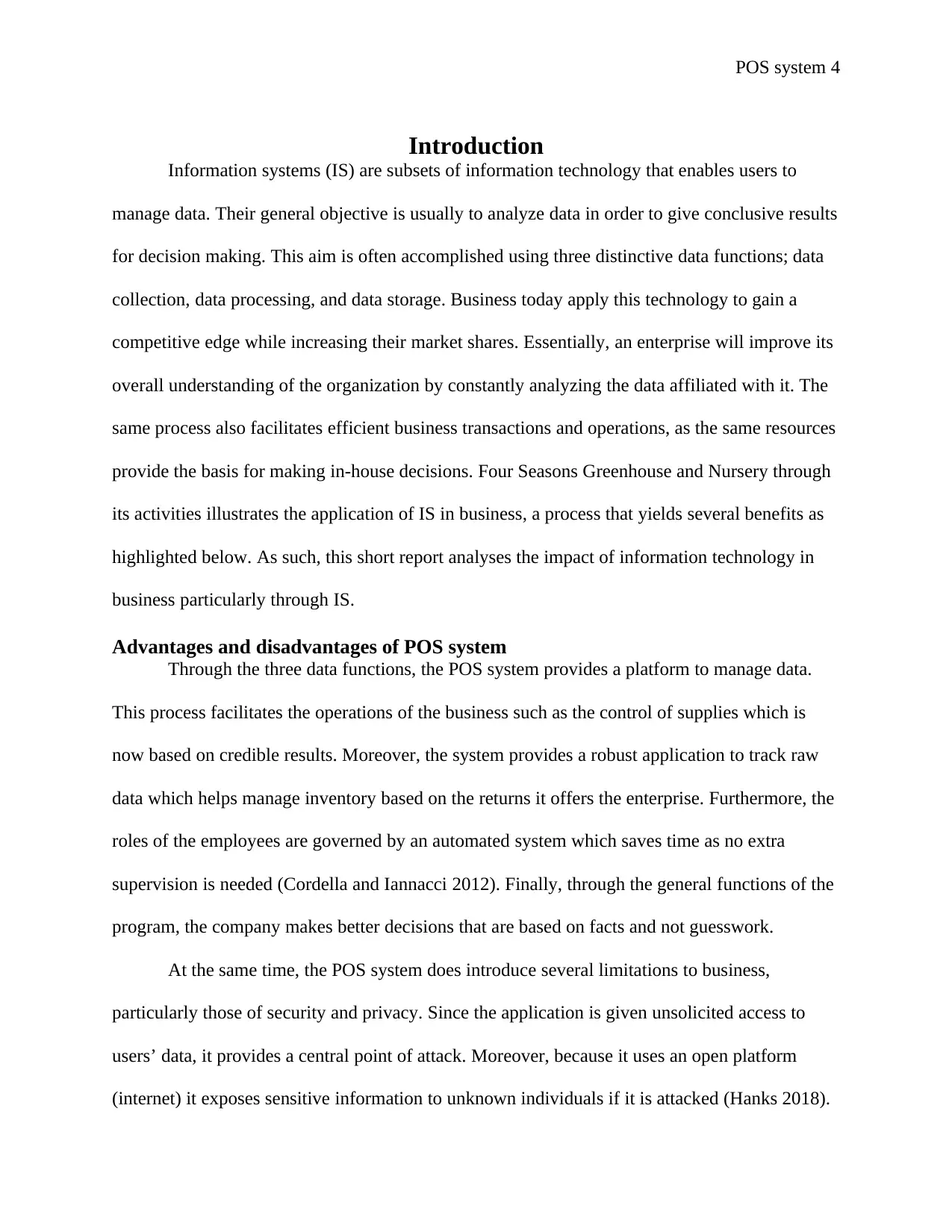
POS system 4
Introduction
Information systems (IS) are subsets of information technology that enables users to
manage data. Their general objective is usually to analyze data in order to give conclusive results
for decision making. This aim is often accomplished using three distinctive data functions; data
collection, data processing, and data storage. Business today apply this technology to gain a
competitive edge while increasing their market shares. Essentially, an enterprise will improve its
overall understanding of the organization by constantly analyzing the data affiliated with it. The
same process also facilitates efficient business transactions and operations, as the same resources
provide the basis for making in-house decisions. Four Seasons Greenhouse and Nursery through
its activities illustrates the application of IS in business, a process that yields several benefits as
highlighted below. As such, this short report analyses the impact of information technology in
business particularly through IS.
Advantages and disadvantages of POS system
Through the three data functions, the POS system provides a platform to manage data.
This process facilitates the operations of the business such as the control of supplies which is
now based on credible results. Moreover, the system provides a robust application to track raw
data which helps manage inventory based on the returns it offers the enterprise. Furthermore, the
roles of the employees are governed by an automated system which saves time as no extra
supervision is needed (Cordella and Iannacci 2012). Finally, through the general functions of the
program, the company makes better decisions that are based on facts and not guesswork.
At the same time, the POS system does introduce several limitations to business,
particularly those of security and privacy. Since the application is given unsolicited access to
users’ data, it provides a central point of attack. Moreover, because it uses an open platform
(internet) it exposes sensitive information to unknown individuals if it is attacked (Hanks 2018).
Introduction
Information systems (IS) are subsets of information technology that enables users to
manage data. Their general objective is usually to analyze data in order to give conclusive results
for decision making. This aim is often accomplished using three distinctive data functions; data
collection, data processing, and data storage. Business today apply this technology to gain a
competitive edge while increasing their market shares. Essentially, an enterprise will improve its
overall understanding of the organization by constantly analyzing the data affiliated with it. The
same process also facilitates efficient business transactions and operations, as the same resources
provide the basis for making in-house decisions. Four Seasons Greenhouse and Nursery through
its activities illustrates the application of IS in business, a process that yields several benefits as
highlighted below. As such, this short report analyses the impact of information technology in
business particularly through IS.
Advantages and disadvantages of POS system
Through the three data functions, the POS system provides a platform to manage data.
This process facilitates the operations of the business such as the control of supplies which is
now based on credible results. Moreover, the system provides a robust application to track raw
data which helps manage inventory based on the returns it offers the enterprise. Furthermore, the
roles of the employees are governed by an automated system which saves time as no extra
supervision is needed (Cordella and Iannacci 2012). Finally, through the general functions of the
program, the company makes better decisions that are based on facts and not guesswork.
At the same time, the POS system does introduce several limitations to business,
particularly those of security and privacy. Since the application is given unsolicited access to
users’ data, it provides a central point of attack. Moreover, because it uses an open platform
(internet) it exposes sensitive information to unknown individuals if it is attacked (Hanks 2018).
Paraphrase This Document
Need a fresh take? Get an instant paraphrase of this document with our AI Paraphraser
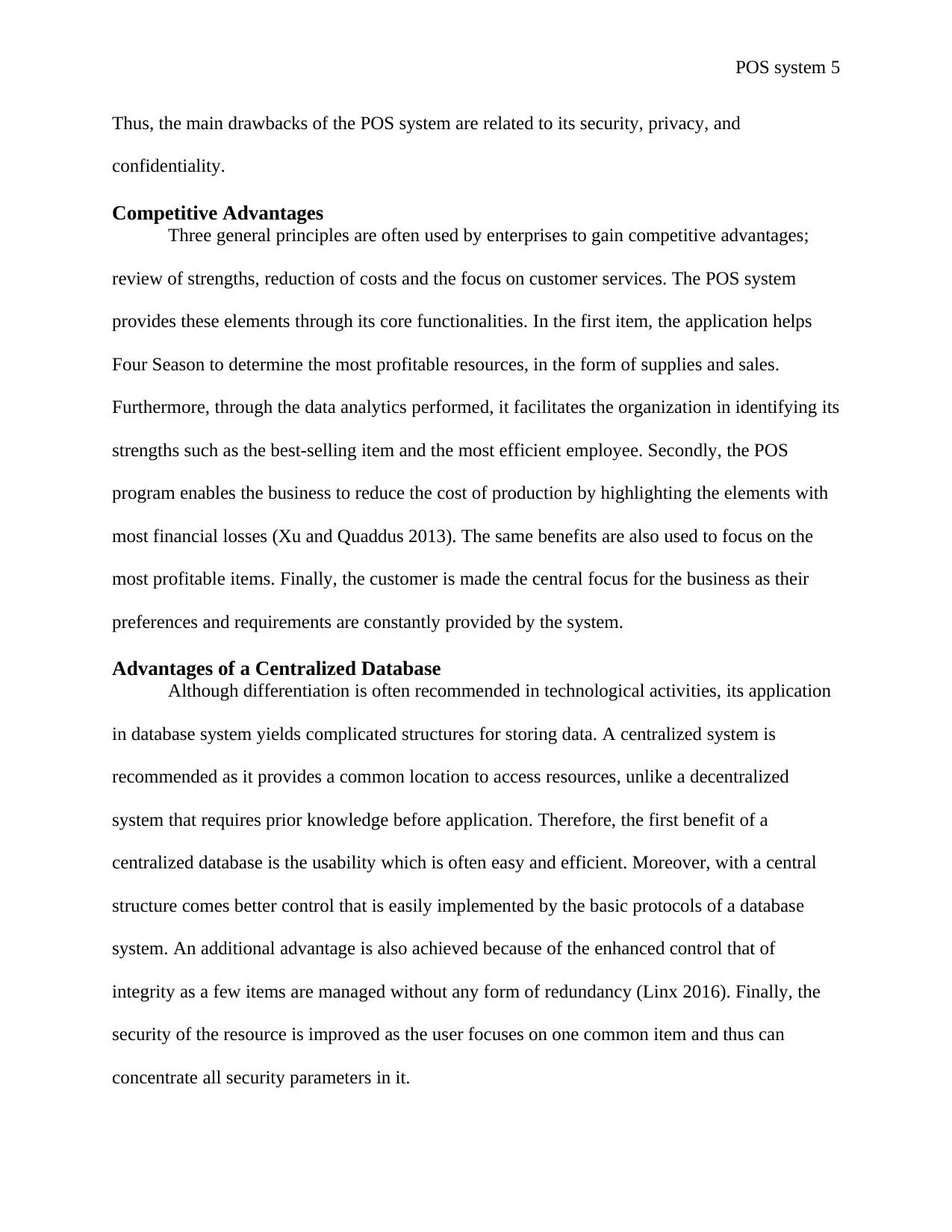
POS system 5
Thus, the main drawbacks of the POS system are related to its security, privacy, and
confidentiality.
Competitive Advantages
Three general principles are often used by enterprises to gain competitive advantages;
review of strengths, reduction of costs and the focus on customer services. The POS system
provides these elements through its core functionalities. In the first item, the application helps
Four Season to determine the most profitable resources, in the form of supplies and sales.
Furthermore, through the data analytics performed, it facilitates the organization in identifying its
strengths such as the best-selling item and the most efficient employee. Secondly, the POS
program enables the business to reduce the cost of production by highlighting the elements with
most financial losses (Xu and Quaddus 2013). The same benefits are also used to focus on the
most profitable items. Finally, the customer is made the central focus for the business as their
preferences and requirements are constantly provided by the system.
Advantages of a Centralized Database
Although differentiation is often recommended in technological activities, its application
in database system yields complicated structures for storing data. A centralized system is
recommended as it provides a common location to access resources, unlike a decentralized
system that requires prior knowledge before application. Therefore, the first benefit of a
centralized database is the usability which is often easy and efficient. Moreover, with a central
structure comes better control that is easily implemented by the basic protocols of a database
system. An additional advantage is also achieved because of the enhanced control that of
integrity as a few items are managed without any form of redundancy (Linx 2016). Finally, the
security of the resource is improved as the user focuses on one common item and thus can
concentrate all security parameters in it.
Thus, the main drawbacks of the POS system are related to its security, privacy, and
confidentiality.
Competitive Advantages
Three general principles are often used by enterprises to gain competitive advantages;
review of strengths, reduction of costs and the focus on customer services. The POS system
provides these elements through its core functionalities. In the first item, the application helps
Four Season to determine the most profitable resources, in the form of supplies and sales.
Furthermore, through the data analytics performed, it facilitates the organization in identifying its
strengths such as the best-selling item and the most efficient employee. Secondly, the POS
program enables the business to reduce the cost of production by highlighting the elements with
most financial losses (Xu and Quaddus 2013). The same benefits are also used to focus on the
most profitable items. Finally, the customer is made the central focus for the business as their
preferences and requirements are constantly provided by the system.
Advantages of a Centralized Database
Although differentiation is often recommended in technological activities, its application
in database system yields complicated structures for storing data. A centralized system is
recommended as it provides a common location to access resources, unlike a decentralized
system that requires prior knowledge before application. Therefore, the first benefit of a
centralized database is the usability which is often easy and efficient. Moreover, with a central
structure comes better control that is easily implemented by the basic protocols of a database
system. An additional advantage is also achieved because of the enhanced control that of
integrity as a few items are managed without any form of redundancy (Linx 2016). Finally, the
security of the resource is improved as the user focuses on one common item and thus can
concentrate all security parameters in it.
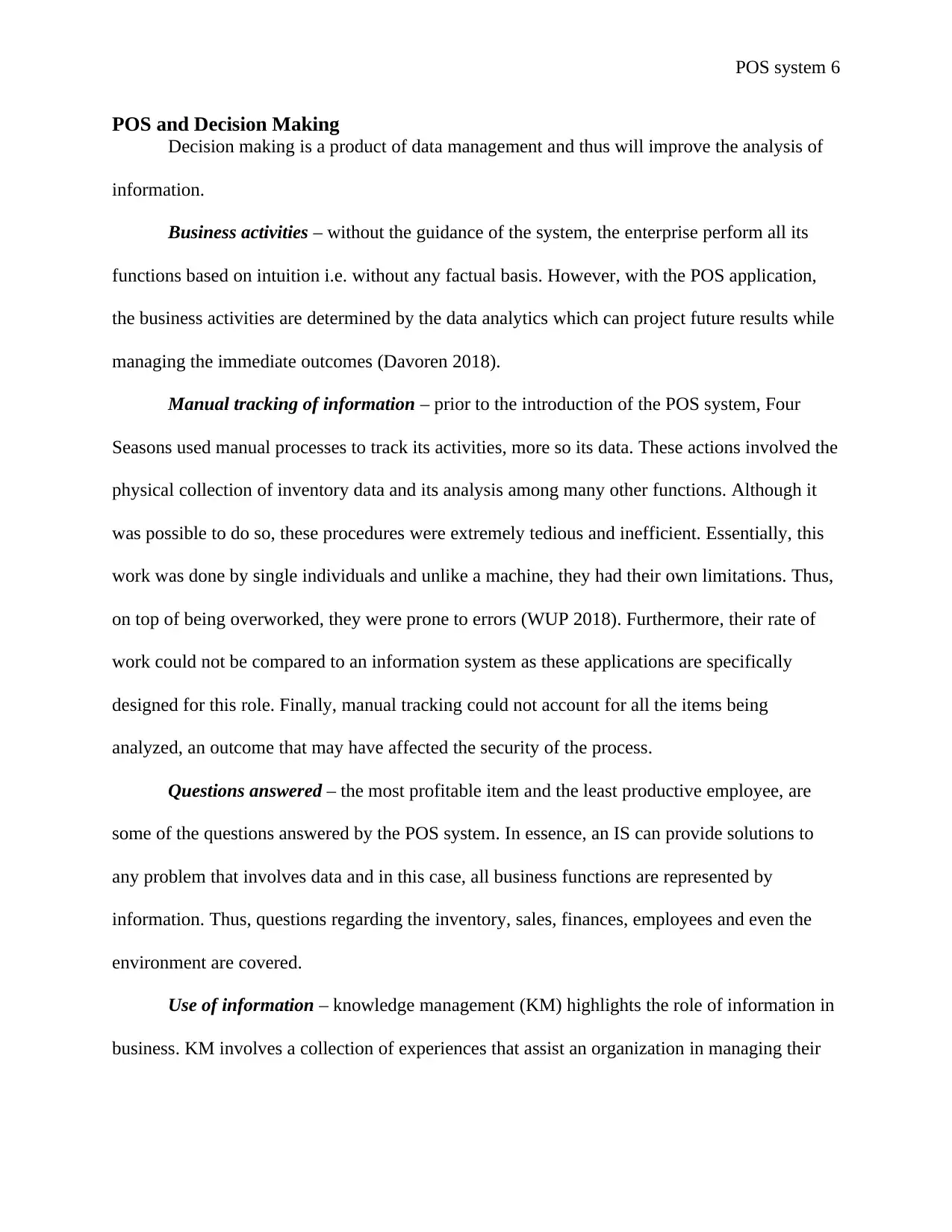
POS system 6
POS and Decision Making
Decision making is a product of data management and thus will improve the analysis of
information.
Business activities – without the guidance of the system, the enterprise perform all its
functions based on intuition i.e. without any factual basis. However, with the POS application,
the business activities are determined by the data analytics which can project future results while
managing the immediate outcomes (Davoren 2018).
Manual tracking of information – prior to the introduction of the POS system, Four
Seasons used manual processes to track its activities, more so its data. These actions involved the
physical collection of inventory data and its analysis among many other functions. Although it
was possible to do so, these procedures were extremely tedious and inefficient. Essentially, this
work was done by single individuals and unlike a machine, they had their own limitations. Thus,
on top of being overworked, they were prone to errors (WUP 2018). Furthermore, their rate of
work could not be compared to an information system as these applications are specifically
designed for this role. Finally, manual tracking could not account for all the items being
analyzed, an outcome that may have affected the security of the process.
Questions answered – the most profitable item and the least productive employee, are
some of the questions answered by the POS system. In essence, an IS can provide solutions to
any problem that involves data and in this case, all business functions are represented by
information. Thus, questions regarding the inventory, sales, finances, employees and even the
environment are covered.
Use of information – knowledge management (KM) highlights the role of information in
business. KM involves a collection of experiences that assist an organization in managing their
POS and Decision Making
Decision making is a product of data management and thus will improve the analysis of
information.
Business activities – without the guidance of the system, the enterprise perform all its
functions based on intuition i.e. without any factual basis. However, with the POS application,
the business activities are determined by the data analytics which can project future results while
managing the immediate outcomes (Davoren 2018).
Manual tracking of information – prior to the introduction of the POS system, Four
Seasons used manual processes to track its activities, more so its data. These actions involved the
physical collection of inventory data and its analysis among many other functions. Although it
was possible to do so, these procedures were extremely tedious and inefficient. Essentially, this
work was done by single individuals and unlike a machine, they had their own limitations. Thus,
on top of being overworked, they were prone to errors (WUP 2018). Furthermore, their rate of
work could not be compared to an information system as these applications are specifically
designed for this role. Finally, manual tracking could not account for all the items being
analyzed, an outcome that may have affected the security of the process.
Questions answered – the most profitable item and the least productive employee, are
some of the questions answered by the POS system. In essence, an IS can provide solutions to
any problem that involves data and in this case, all business functions are represented by
information. Thus, questions regarding the inventory, sales, finances, employees and even the
environment are covered.
Use of information – knowledge management (KM) highlights the role of information in
business. KM involves a collection of experiences that assist an organization in managing their
⊘ This is a preview!⊘
Do you want full access?
Subscribe today to unlock all pages.

Trusted by 1+ million students worldwide
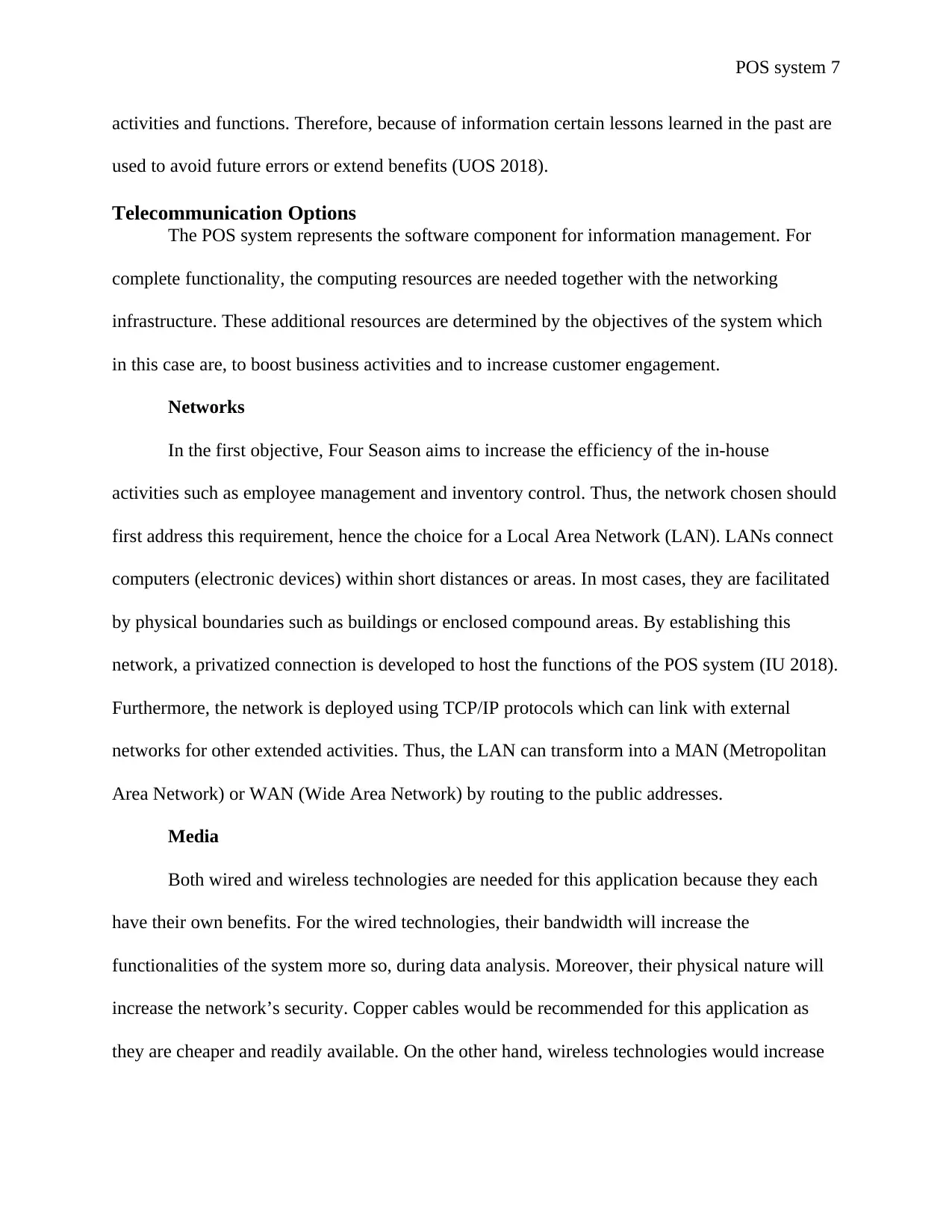
POS system 7
activities and functions. Therefore, because of information certain lessons learned in the past are
used to avoid future errors or extend benefits (UOS 2018).
Telecommunication Options
The POS system represents the software component for information management. For
complete functionality, the computing resources are needed together with the networking
infrastructure. These additional resources are determined by the objectives of the system which
in this case are, to boost business activities and to increase customer engagement.
Networks
In the first objective, Four Season aims to increase the efficiency of the in-house
activities such as employee management and inventory control. Thus, the network chosen should
first address this requirement, hence the choice for a Local Area Network (LAN). LANs connect
computers (electronic devices) within short distances or areas. In most cases, they are facilitated
by physical boundaries such as buildings or enclosed compound areas. By establishing this
network, a privatized connection is developed to host the functions of the POS system (IU 2018).
Furthermore, the network is deployed using TCP/IP protocols which can link with external
networks for other extended activities. Thus, the LAN can transform into a MAN (Metropolitan
Area Network) or WAN (Wide Area Network) by routing to the public addresses.
Media
Both wired and wireless technologies are needed for this application because they each
have their own benefits. For the wired technologies, their bandwidth will increase the
functionalities of the system more so, during data analysis. Moreover, their physical nature will
increase the network’s security. Copper cables would be recommended for this application as
they are cheaper and readily available. On the other hand, wireless technologies would increase
activities and functions. Therefore, because of information certain lessons learned in the past are
used to avoid future errors or extend benefits (UOS 2018).
Telecommunication Options
The POS system represents the software component for information management. For
complete functionality, the computing resources are needed together with the networking
infrastructure. These additional resources are determined by the objectives of the system which
in this case are, to boost business activities and to increase customer engagement.
Networks
In the first objective, Four Season aims to increase the efficiency of the in-house
activities such as employee management and inventory control. Thus, the network chosen should
first address this requirement, hence the choice for a Local Area Network (LAN). LANs connect
computers (electronic devices) within short distances or areas. In most cases, they are facilitated
by physical boundaries such as buildings or enclosed compound areas. By establishing this
network, a privatized connection is developed to host the functions of the POS system (IU 2018).
Furthermore, the network is deployed using TCP/IP protocols which can link with external
networks for other extended activities. Thus, the LAN can transform into a MAN (Metropolitan
Area Network) or WAN (Wide Area Network) by routing to the public addresses.
Media
Both wired and wireless technologies are needed for this application because they each
have their own benefits. For the wired technologies, their bandwidth will increase the
functionalities of the system more so, during data analysis. Moreover, their physical nature will
increase the network’s security. Copper cables would be recommended for this application as
they are cheaper and readily available. On the other hand, wireless technologies would increase
Paraphrase This Document
Need a fresh take? Get an instant paraphrase of this document with our AI Paraphraser
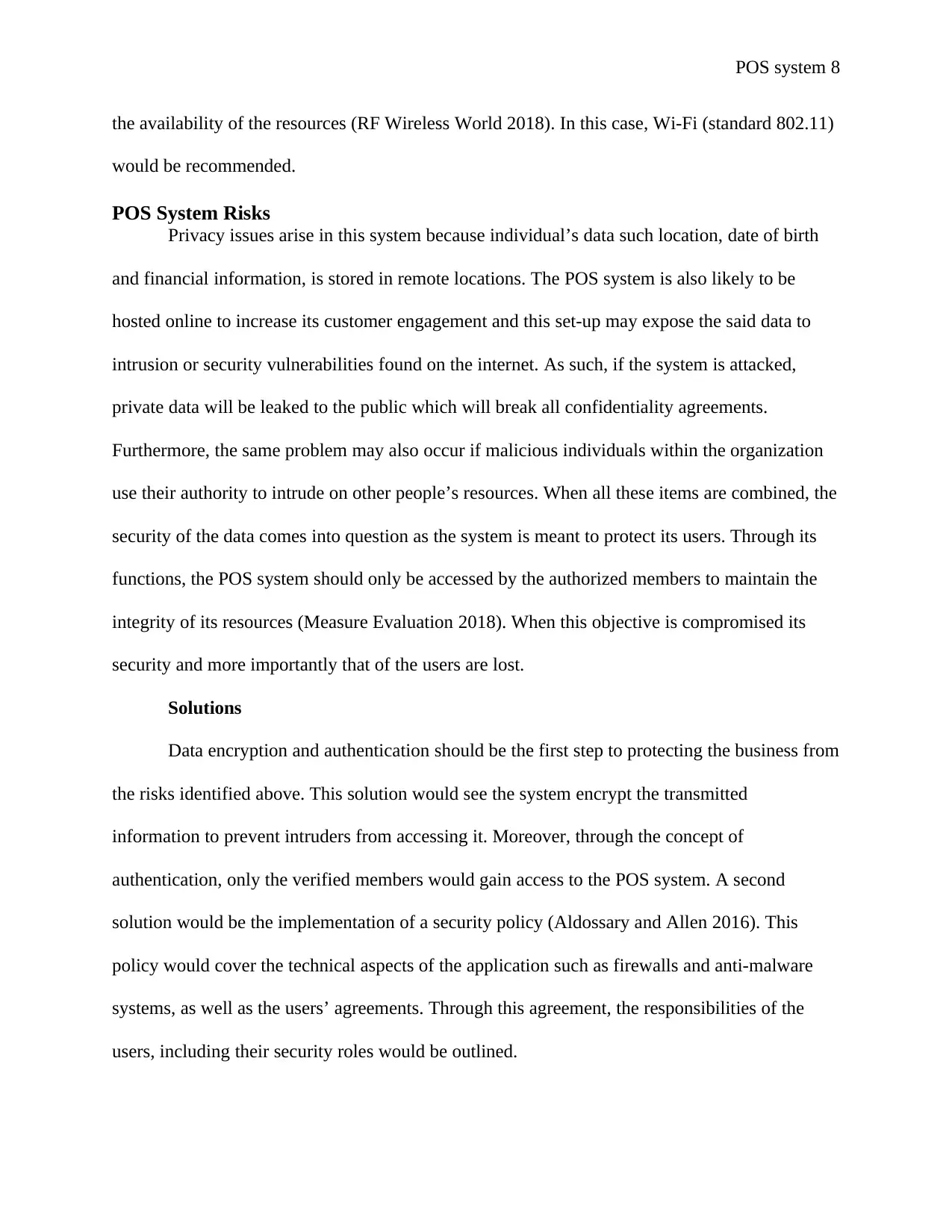
POS system 8
the availability of the resources (RF Wireless World 2018). In this case, Wi-Fi (standard 802.11)
would be recommended.
POS System Risks
Privacy issues arise in this system because individual’s data such location, date of birth
and financial information, is stored in remote locations. The POS system is also likely to be
hosted online to increase its customer engagement and this set-up may expose the said data to
intrusion or security vulnerabilities found on the internet. As such, if the system is attacked,
private data will be leaked to the public which will break all confidentiality agreements.
Furthermore, the same problem may also occur if malicious individuals within the organization
use their authority to intrude on other people’s resources. When all these items are combined, the
security of the data comes into question as the system is meant to protect its users. Through its
functions, the POS system should only be accessed by the authorized members to maintain the
integrity of its resources (Measure Evaluation 2018). When this objective is compromised its
security and more importantly that of the users are lost.
Solutions
Data encryption and authentication should be the first step to protecting the business from
the risks identified above. This solution would see the system encrypt the transmitted
information to prevent intruders from accessing it. Moreover, through the concept of
authentication, only the verified members would gain access to the POS system. A second
solution would be the implementation of a security policy (Aldossary and Allen 2016). This
policy would cover the technical aspects of the application such as firewalls and anti-malware
systems, as well as the users’ agreements. Through this agreement, the responsibilities of the
users, including their security roles would be outlined.
the availability of the resources (RF Wireless World 2018). In this case, Wi-Fi (standard 802.11)
would be recommended.
POS System Risks
Privacy issues arise in this system because individual’s data such location, date of birth
and financial information, is stored in remote locations. The POS system is also likely to be
hosted online to increase its customer engagement and this set-up may expose the said data to
intrusion or security vulnerabilities found on the internet. As such, if the system is attacked,
private data will be leaked to the public which will break all confidentiality agreements.
Furthermore, the same problem may also occur if malicious individuals within the organization
use their authority to intrude on other people’s resources. When all these items are combined, the
security of the data comes into question as the system is meant to protect its users. Through its
functions, the POS system should only be accessed by the authorized members to maintain the
integrity of its resources (Measure Evaluation 2018). When this objective is compromised its
security and more importantly that of the users are lost.
Solutions
Data encryption and authentication should be the first step to protecting the business from
the risks identified above. This solution would see the system encrypt the transmitted
information to prevent intruders from accessing it. Moreover, through the concept of
authentication, only the verified members would gain access to the POS system. A second
solution would be the implementation of a security policy (Aldossary and Allen 2016). This
policy would cover the technical aspects of the application such as firewalls and anti-malware
systems, as well as the users’ agreements. Through this agreement, the responsibilities of the
users, including their security roles would be outlined.
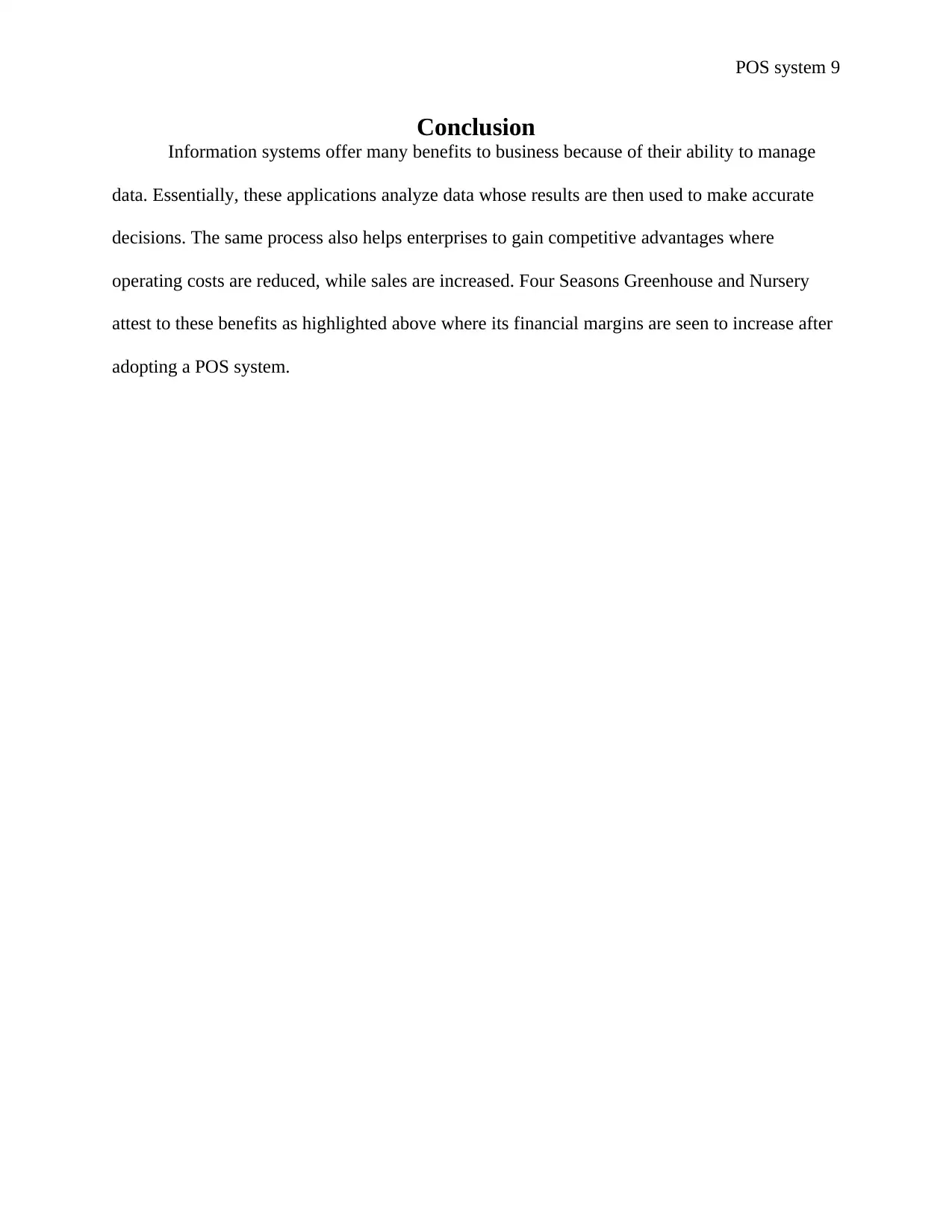
POS system 9
Conclusion
Information systems offer many benefits to business because of their ability to manage
data. Essentially, these applications analyze data whose results are then used to make accurate
decisions. The same process also helps enterprises to gain competitive advantages where
operating costs are reduced, while sales are increased. Four Seasons Greenhouse and Nursery
attest to these benefits as highlighted above where its financial margins are seen to increase after
adopting a POS system.
Conclusion
Information systems offer many benefits to business because of their ability to manage
data. Essentially, these applications analyze data whose results are then used to make accurate
decisions. The same process also helps enterprises to gain competitive advantages where
operating costs are reduced, while sales are increased. Four Seasons Greenhouse and Nursery
attest to these benefits as highlighted above where its financial margins are seen to increase after
adopting a POS system.
⊘ This is a preview!⊘
Do you want full access?
Subscribe today to unlock all pages.

Trusted by 1+ million students worldwide
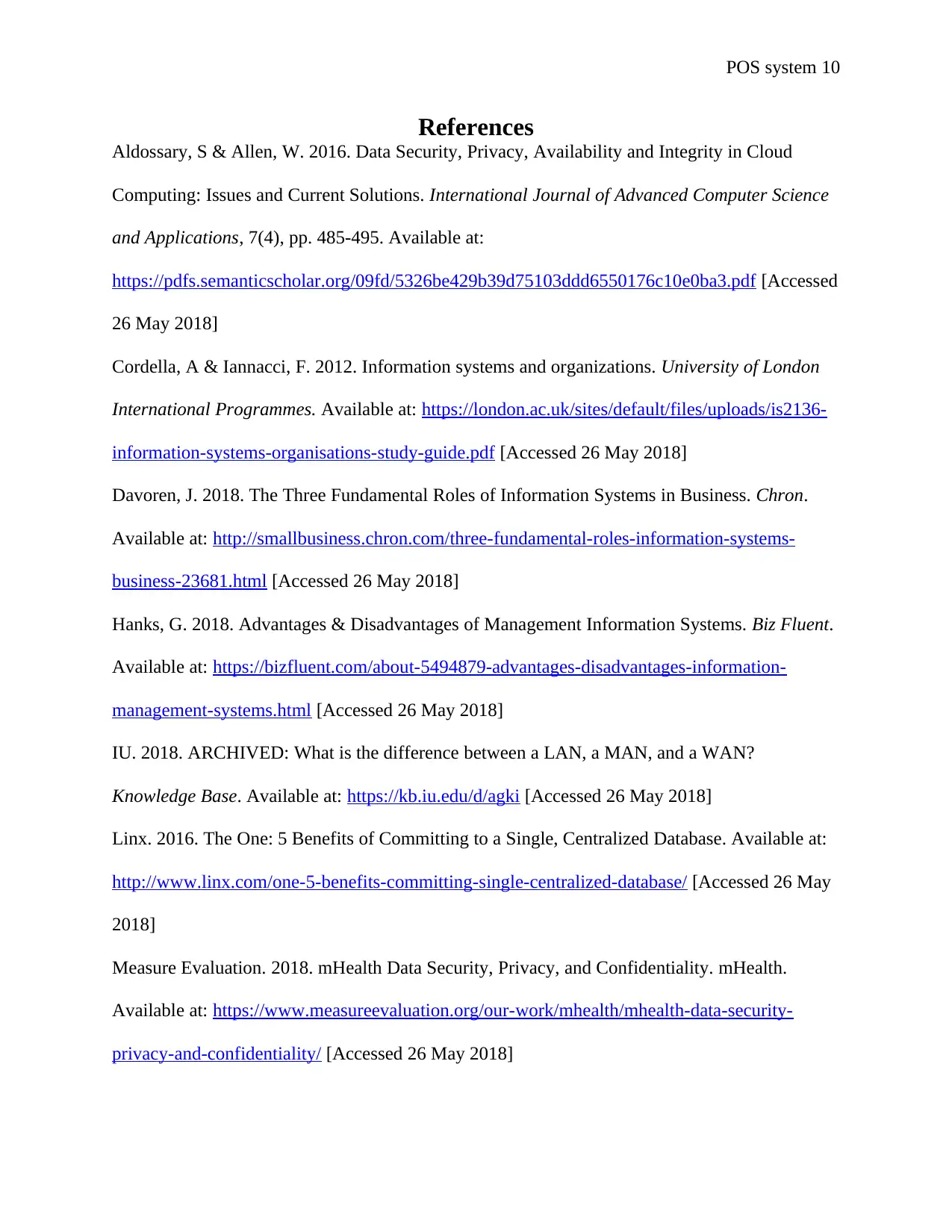
POS system 10
References
Aldossary, S & Allen, W. 2016. Data Security, Privacy, Availability and Integrity in Cloud
Computing: Issues and Current Solutions. International Journal of Advanced Computer Science
and Applications, 7(4), pp. 485-495. Available at:
https://pdfs.semanticscholar.org/09fd/5326be429b39d75103ddd6550176c10e0ba3.pdf [Accessed
26 May 2018]
Cordella, A & Iannacci, F. 2012. Information systems and organizations. University of London
International Programmes. Available at: https://london.ac.uk/sites/default/files/uploads/is2136-
information-systems-organisations-study-guide.pdf [Accessed 26 May 2018]
Davoren, J. 2018. The Three Fundamental Roles of Information Systems in Business. Chron.
Available at: http://smallbusiness.chron.com/three-fundamental-roles-information-systems-
business-23681.html [Accessed 26 May 2018]
Hanks, G. 2018. Advantages & Disadvantages of Management Information Systems. Biz Fluent.
Available at: https://bizfluent.com/about-5494879-advantages-disadvantages-information-
management-systems.html [Accessed 26 May 2018]
IU. 2018. ARCHIVED: What is the difference between a LAN, a MAN, and a WAN?
Knowledge Base. Available at: https://kb.iu.edu/d/agki [Accessed 26 May 2018]
Linx. 2016. The One: 5 Benefits of Committing to a Single, Centralized Database. Available at:
http://www.linx.com/one-5-benefits-committing-single-centralized-database/ [Accessed 26 May
2018]
Measure Evaluation. 2018. mHealth Data Security, Privacy, and Confidentiality. mHealth.
Available at: https://www.measureevaluation.org/our-work/mhealth/mhealth-data-security-
privacy-and-confidentiality/ [Accessed 26 May 2018]
References
Aldossary, S & Allen, W. 2016. Data Security, Privacy, Availability and Integrity in Cloud
Computing: Issues and Current Solutions. International Journal of Advanced Computer Science
and Applications, 7(4), pp. 485-495. Available at:
https://pdfs.semanticscholar.org/09fd/5326be429b39d75103ddd6550176c10e0ba3.pdf [Accessed
26 May 2018]
Cordella, A & Iannacci, F. 2012. Information systems and organizations. University of London
International Programmes. Available at: https://london.ac.uk/sites/default/files/uploads/is2136-
information-systems-organisations-study-guide.pdf [Accessed 26 May 2018]
Davoren, J. 2018. The Three Fundamental Roles of Information Systems in Business. Chron.
Available at: http://smallbusiness.chron.com/three-fundamental-roles-information-systems-
business-23681.html [Accessed 26 May 2018]
Hanks, G. 2018. Advantages & Disadvantages of Management Information Systems. Biz Fluent.
Available at: https://bizfluent.com/about-5494879-advantages-disadvantages-information-
management-systems.html [Accessed 26 May 2018]
IU. 2018. ARCHIVED: What is the difference between a LAN, a MAN, and a WAN?
Knowledge Base. Available at: https://kb.iu.edu/d/agki [Accessed 26 May 2018]
Linx. 2016. The One: 5 Benefits of Committing to a Single, Centralized Database. Available at:
http://www.linx.com/one-5-benefits-committing-single-centralized-database/ [Accessed 26 May
2018]
Measure Evaluation. 2018. mHealth Data Security, Privacy, and Confidentiality. mHealth.
Available at: https://www.measureevaluation.org/our-work/mhealth/mhealth-data-security-
privacy-and-confidentiality/ [Accessed 26 May 2018]
Paraphrase This Document
Need a fresh take? Get an instant paraphrase of this document with our AI Paraphraser
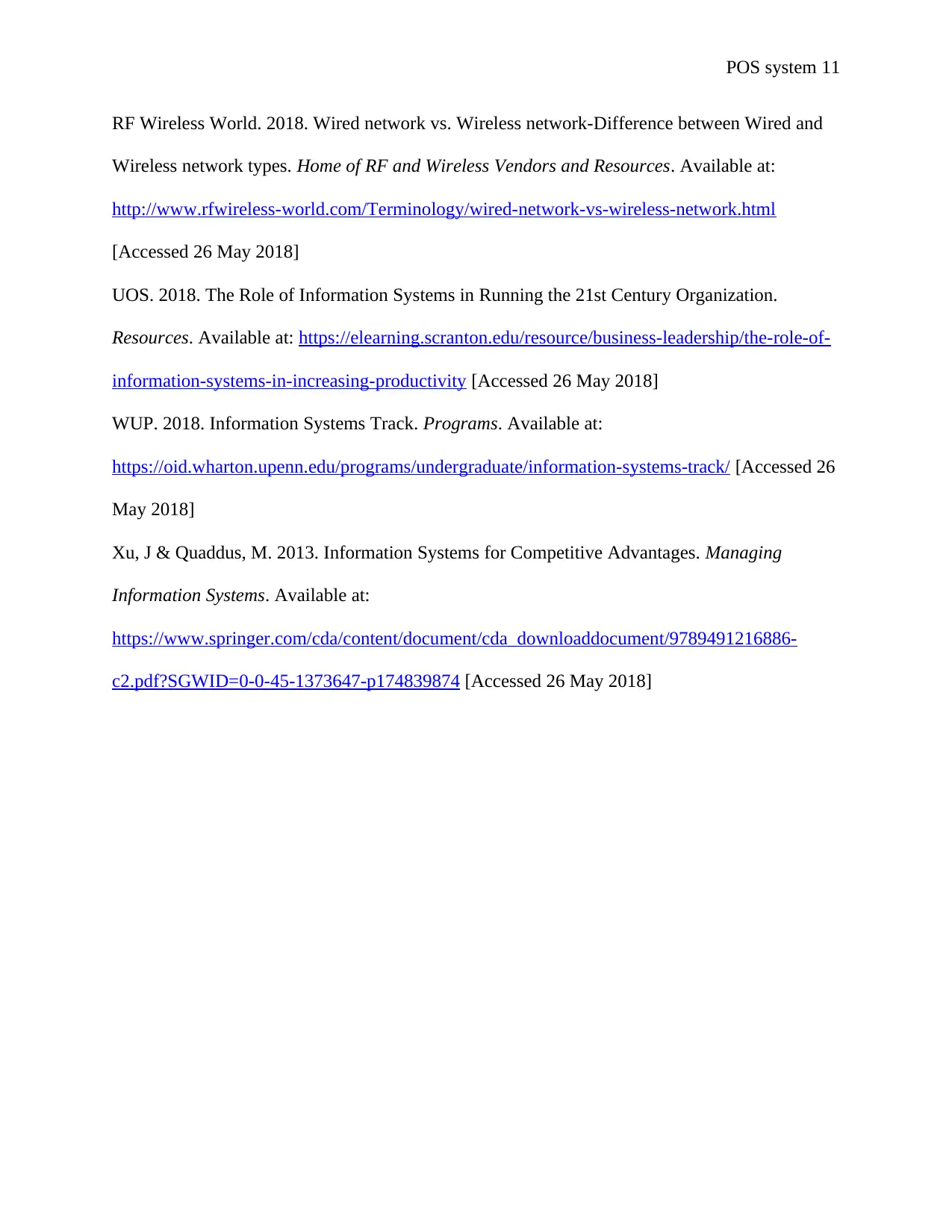
POS system 11
RF Wireless World. 2018. Wired network vs. Wireless network-Difference between Wired and
Wireless network types. Home of RF and Wireless Vendors and Resources. Available at:
http://www.rfwireless-world.com/Terminology/wired-network-vs-wireless-network.html
[Accessed 26 May 2018]
UOS. 2018. The Role of Information Systems in Running the 21st Century Organization.
Resources. Available at: https://elearning.scranton.edu/resource/business-leadership/the-role-of-
information-systems-in-increasing-productivity [Accessed 26 May 2018]
WUP. 2018. Information Systems Track. Programs. Available at:
https://oid.wharton.upenn.edu/programs/undergraduate/information-systems-track/ [Accessed 26
May 2018]
Xu, J & Quaddus, M. 2013. Information Systems for Competitive Advantages. Managing
Information Systems. Available at:
https://www.springer.com/cda/content/document/cda_downloaddocument/9789491216886-
c2.pdf?SGWID=0-0-45-1373647-p174839874 [Accessed 26 May 2018]
RF Wireless World. 2018. Wired network vs. Wireless network-Difference between Wired and
Wireless network types. Home of RF and Wireless Vendors and Resources. Available at:
http://www.rfwireless-world.com/Terminology/wired-network-vs-wireless-network.html
[Accessed 26 May 2018]
UOS. 2018. The Role of Information Systems in Running the 21st Century Organization.
Resources. Available at: https://elearning.scranton.edu/resource/business-leadership/the-role-of-
information-systems-in-increasing-productivity [Accessed 26 May 2018]
WUP. 2018. Information Systems Track. Programs. Available at:
https://oid.wharton.upenn.edu/programs/undergraduate/information-systems-track/ [Accessed 26
May 2018]
Xu, J & Quaddus, M. 2013. Information Systems for Competitive Advantages. Managing
Information Systems. Available at:
https://www.springer.com/cda/content/document/cda_downloaddocument/9789491216886-
c2.pdf?SGWID=0-0-45-1373647-p174839874 [Accessed 26 May 2018]
1 out of 11
Related Documents
Your All-in-One AI-Powered Toolkit for Academic Success.
+13062052269
info@desklib.com
Available 24*7 on WhatsApp / Email
![[object Object]](/_next/static/media/star-bottom.7253800d.svg)
Unlock your academic potential
Copyright © 2020–2025 A2Z Services. All Rights Reserved. Developed and managed by ZUCOL.




